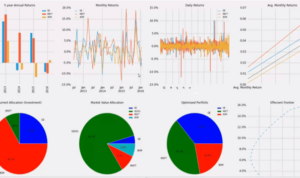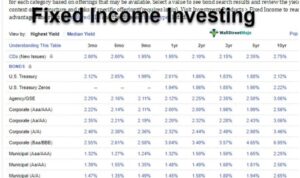Step into the realm of high-yield investment programs where risks mingle with promises of high returns. Get ready for a rollercoaster ride filled with insights and cautionary tales, as we explore the ins and outs of this intriguing investment landscape.
In the following paragraphs, we will delve into the definition, types, identification methods, legal aspects, and risk mitigation strategies associated with high-yield investment programs.
What are High-Yield Investment Programs (HYIPs)?
High-Yield Investment Programs, or HYIPs, are investment schemes that promise high returns to investors in a short period of time. These programs typically operate online and claim to invest funds in various high-risk ventures such as forex trading, cryptocurrencies, or real estate.
Characteristics of HYIPs
- HYIPs offer unrealistically high returns, often ranging from 1% to 10% daily or even higher.
- They have a short lifespan, with most collapsing within a few months or even weeks.
- HYIPs often use referral programs to attract new investors and sustain payouts to existing ones.
- They lack transparency and regulatory oversight, making them prone to scams and Ponzi schemes.
Risks of Investing in HYIPs
- Investors can lose all their funds if the HYIP collapses suddenly or stops paying out.
- There is a high risk of fraud, as many HYIPs turn out to be Ponzi schemes that rely on new investors to pay returns to existing ones.
- Due to the lack of regulation, there is no legal recourse for investors who fall victim to HYIP scams.
- HYIPs often have vague or misleading information about their investment strategies, making it difficult to assess the true risk involved.
Common Types of HYIPs
When it comes to High-Yield Investment Programs (HYIPs), there are various types that investors should be aware of. These types include Ponzi schemes, pyramid schemes, and forex trading programs. Each type has its own unique characteristics and risks associated with them.
Ponzi Schemes
Ponzi schemes are one of the most common types of HYIPs. In this scheme, the returns that earlier investors receive come from the capital of new investors rather than from profits earned through legitimate investment activities. This unsustainable model eventually collapses when there are not enough new investors to pay returns to earlier investors. One well-known example of a Ponzi scheme is the infamous Bernie Madoff scandal.
Pyramid Schemes
Pyramid schemes operate by recruiting new members who make payments to existing members. The new members are then encouraged to recruit even more members, with the promise of high returns. The profits are derived mainly from recruitment fees rather than from the sale of actual products or services. Once recruitment slows down, the scheme collapses. An example of a pyramid scheme is the case of the company called “Zeek Rewards.”
Forex Trading Programs
Forex trading programs promise high returns through speculative trading in the foreign exchange market. While legitimate forex trading can yield profits, some HYIPs falsely claim to generate high returns through forex trading without actually engaging in any trading activity. Investors should be cautious of such programs as they often turn out to be scams. One example of a forex trading HYIP is the “Profitable Morrows” scheme.
How to Identify High-Yield Investment Programs
Investing in High-Yield Investment Programs (HYIPs) can be risky, so it’s crucial to know how to identify legitimate opportunities from potential scams.
Red Flags and Warning Signs
- Unrealistically High Returns: Be cautious of HYIPs promising extremely high returns within a short period.
- Lack of Transparency: Avoid programs that do not provide clear information about their investment strategies or team.
- Pressure to Invest Quickly: Stay away from HYIPs that pressure you to invest immediately without giving you time to conduct proper research.
- Anonymous Owners: If the people behind the program are not transparent or difficult to identify, it could be a red flag.
Importance of Due Diligence
Before investing in any HYIP, it’s essential to conduct thorough due diligence. Research the program, check reviews, and verify the legitimacy of the investment opportunity.
Distinguishing Legitimate Opportunities from Fraudulent Schemes
- Check for Registration and Licensing: Legitimate HYIPs are usually registered and licensed with relevant authorities.
- Transparent Investment Plans: Look for programs that clearly Artikel their investment strategies and risks involved.
- Communication and Support: Legitimate programs have responsive customer support and clear communication channels.
- Avoid Unrealistic Promises: If an HYIP promises guaranteed returns or sounds too good to be true, it’s likely a fraudulent scheme.
Legal Aspects and Regulation of HYIPs

In the world of High-Yield Investment Programs (HYIPs), the legal landscape can vary significantly from country to country. While some nations have strict regulations in place to monitor and control HYIP activities, others may have more relaxed or non-existent laws regarding these investment schemes. This lack of uniformity makes it challenging for regulators to combat fraudulent HYIPs effectively.
Regulatory Measures in Different Countries
In the United States, the Securities and Exchange Commission (SEC) plays a crucial role in regulating investment activities, including HYIPs. Any investment opportunity that promises high returns with little to no risk must be registered with the SEC to ensure compliance with securities laws. Failure to do so can result in legal action and penalties.
In the United Kingdom, the Financial Conduct Authority (FCA) oversees financial markets and investment firms, including those offering high-yield investment programs. The FCA works to protect investors by ensuring that companies comply with regulations and disclose accurate information about their investment products.
Challenges Faced by Regulators
Regulators face several challenges when trying to combat fraudulent HYIPs. One of the main obstacles is the ability of scammers to operate across borders, making it difficult for local authorities to track and prosecute them effectively. Additionally, the anonymous nature of many HYIPs makes it challenging to identify the individuals behind these schemes, further complicating regulatory efforts.
Another challenge is the constantly evolving nature of HYIP scams, with fraudsters adapting their tactics to bypass existing regulations and detection measures. This cat-and-mouse game requires regulators to stay vigilant and continually update their strategies to keep up with the changing landscape of fraudulent investment schemes.
Strategies for Mitigating Risks in HYIP Investments
Investing in High-Yield Investment Programs (HYIPs) can be risky due to the potential for scams and fraud. However, there are strategies you can implement to minimize these risks and protect your investments.
Diversification Techniques
Diversifying your investments across different HYIPs can help spread out the risk. By not putting all your funds into one program, you reduce the impact of potential losses if one of the programs fails. Consider investing in a variety of HYIPs with different terms, interest rates, and risk levels to create a diversified portfolio.
Risk Management Plan
Creating a risk management plan for your HYIP investments is crucial. Define your risk tolerance and set clear investment goals. Determine how much you are willing to invest in HYIPs and establish stop-loss limits to protect your capital. Regularly monitor your investments and be prepared to exit a program if it shows signs of trouble.
Due Diligence
Before investing in any HYIP, conduct thorough research to verify the legitimacy of the program. Check for reviews, testimonials, and online forums to gather information from other investors. Look for transparency in the program’s operations and read the terms and conditions carefully. Avoid programs that promise unrealistic returns or use aggressive marketing tactics.
Stay Informed
Stay updated on the latest news and trends in the HYIP industry. Follow reputable financial news sources and forums to stay informed about potential red flags or warning signs. Keep an eye out for any changes in the program’s performance or management team. Being proactive and informed can help you make better investment decisions.
Exit Strategy
Having a clear exit strategy is essential in HYIP investments. Determine your profit targets and set a timeline for when you plan to withdraw your earnings. Consider reinvesting a portion of your profits while withdrawing the rest to protect your initial investment. Be prepared to exit a program if it shows signs of instability or if your risk management plan dictates it.






